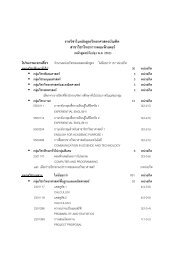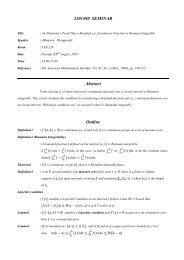Lecture Notes Topology (2301631) Phichet Chaoha Department of ...
Lecture Notes Topology (2301631) Phichet Chaoha Department of ...
Lecture Notes Topology (2301631) Phichet Chaoha Department of ...
You also want an ePaper? Increase the reach of your titles
YUMPU automatically turns print PDFs into web optimized ePapers that Google loves.
<strong>Phichet</strong> <strong>Chaoha</strong> 49<br />
Pro<strong>of</strong>. Let X be a compact Hausdorff space. Let A and B be disjoint<br />
closed subsets <strong>of</strong> X. By Theorem 4.11, the sets A and B are compact. Also,<br />
by Lemma 4.12, for each a ∈ A, there are disjoint neighborhoods U a <strong>of</strong> a and V a <strong>of</strong><br />
B. Since {U a } a∈A forms an open covering <strong>of</strong> A and A is compact, there is a finite<br />
subcollection {U ai } n i=1 that covers A. By letting U = ∪n i=1 U a i<br />
and V = ∩ n i=1 V a i<br />
, it<br />
is easy to check that U and V are disjoint neighborhoods <strong>of</strong> A and B, respectively.<br />
Therefore, X is normal.<br />
□<br />
Theorem 4.16. If X is a compact space and f : X → Y is a continuous map,<br />
then f(X) is also compact.<br />
Pro<strong>of</strong>. Suppose X is a compact space and f : X → Y is a continuous map.<br />
Let {U α } α∈Λ be an open covering <strong>of</strong> f(X). Then, {f −1 (U α )} α∈Λ clearly forms<br />
an open covering <strong>of</strong> X and, by compactness, it has a finite subcovering, says<br />
{f −1 (U αi )} n i=1 . Hence, {U α i<br />
} n i=1 is the desired finite subcollection <strong>of</strong> {U α} α∈Λ<br />
that still covers f(X).<br />
□<br />
Example 4.17. A quotient space <strong>of</strong> a compact space is always compact.<br />
Corollary 4.18. Compactness is a topological property.<br />
Theorem 4.19. A bijective continuous map from a compact space onto a Hausdorff<br />
space is a homeomorphism.<br />
Pro<strong>of</strong>. To show that f −1 is continuous, let C be a closed subset <strong>of</strong> X. Since X<br />
is compact, then so is C (by Theorem 4.11). Since f is continuous, by the previous<br />
theorem, f(C) is compact in Y . Finally, since Y is Hausdorff, it follows directly by<br />
Theorem 4.13 that f(C) is closed in Y .<br />
□<br />
Example 4.20. Let C = {(x, y) : x 2 + y 2 = 1} ⊆ R 2 and f : I → C be given<br />
by f(t) = (cos 2πt, sin 2πt). Clearly, f is continuous. Also, let p : I → I /∼ = S 1 be<br />
the quotient map where ∼ is given by 0 ∼ 1. So, f is constant on each fiber <strong>of</strong> p<br />
and hence it induces a continuous map ˜f : S 1 → C such that ˜f ◦ p = f. It is easy<br />
to see that ˜f is bijective. Since S 1 is compact and C is Hausdorff, ˜f is in fact a<br />
homeomorphism; i.e., S 1 ∼ = C.<br />
Theorem 4.21 (Extreme Value Theorem). If X is a compact space and f :<br />
X → R is a continuous map, then f attains its minimum and maximum on X.<br />
Pro<strong>of</strong>. Suppose that f does not attain its minimum on X; i.e., for each<br />
z ∈ f(X), there exists y ∈ f(X) such that y < z. Then the collection {(y, ∞) | y ∈<br />
f(X)} clearly forms an open covering <strong>of</strong> f(X). Since f(X) is compact, we obtain<br />
a finite subcovering <strong>of</strong> f(X), says {(y 1 , ∞), (y 2 , ∞), . . . , (y n , ∞)}. Hence,<br />
f(X) ⊆ (y min , ∞) where y min = min{y 1 , y 2 , . . . , y n }. This is clearly a contradition<br />
since y min ∈ f(X) but y min /∈ (y min , ∞). Therefore, f must attain its minimum.<br />
Similarly, we can show that f attains its maximum as well.<br />
□<br />
Definition 4.22. Let (X, d) be a metric space, ∅ ̸= A ⊆ X and x ∈ X. We<br />
define the diameter <strong>of</strong> A, denoted by diam(A), and the distance between x and A,<br />
denoted by d(x, A), as follows :<br />
diam(A) = sup{d(a, b) | a, b ∈ A},<br />
d(x, A) = inf{d(x, a) | a ∈ A}.





